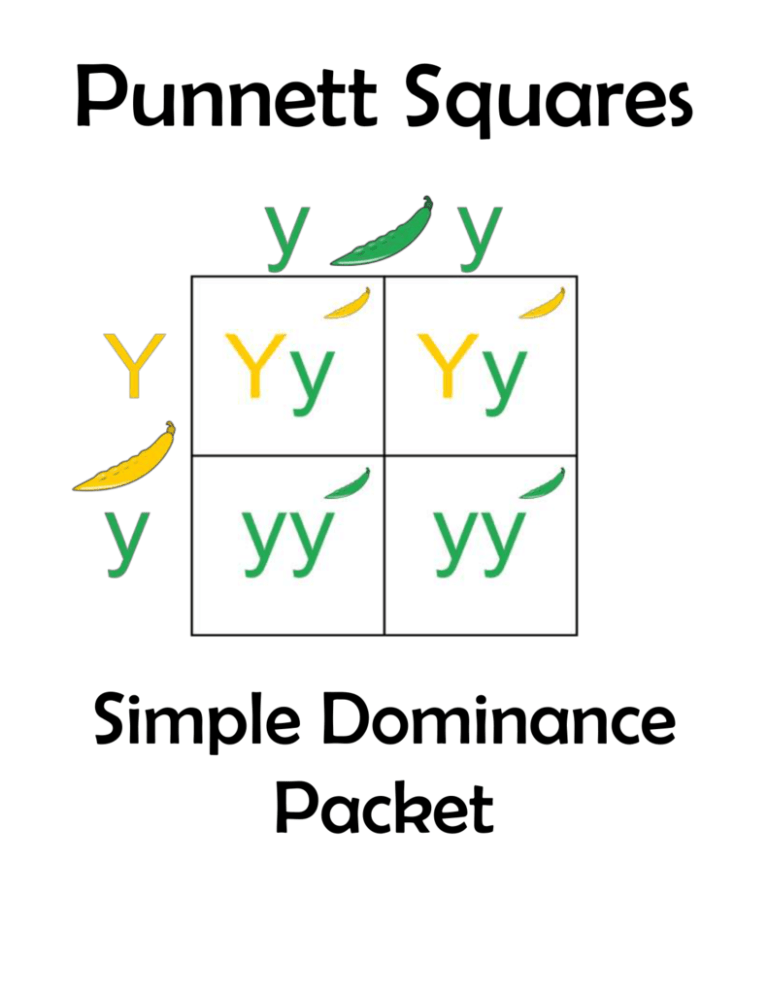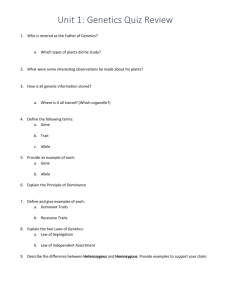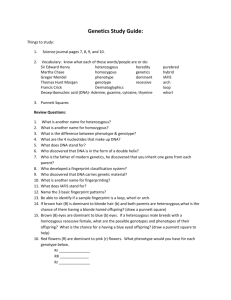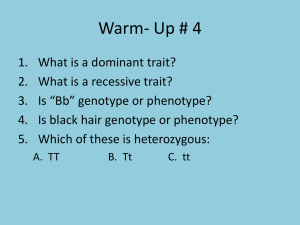Punnett Square Word Problems
advertisement

Punnett Squares Simple Dominance Packet Name: ______________________________________________________________ Page 1 Punnett Squares: Crosses Involving One Trait “What Color is the Pod?” Green (G) is the dominant color for pods of peas. Yellow (g) is recessive. 1. What are the phenotypes of the following genotypes? a. GG b. Gg c. gg 2. Fill in the Punnett Squares below to show the outcomes of the crosses. Next to each genotype, write the correct phenotype. a.) GG x Gg c.) Gg x Gg b.) GG x gg d.) Gg x gg Page 2 “Animal Fur” In a certain species of animal, black fur (B) is dominant over brown fur (b). Using the following Punnett square, predict the genotypes and phenotypes of the offspring whose parents are both Bb or have heterozygous black fur. B b Genotypes: _____% homozygous black fur (BB) B b _____% heterozygous black fur (Bb) _____% homozygous brown fur (bb) Phenotypes: _____% black fur _____% brown fur Now do the same when one parent is homozygous black (BB) and the other is homozygous brown (bb). Genotypes: _____% homozygous black fur (BB) _____% heterozygous black fur (Bb) _____% homozygous brown fur (bb) Phenotypes: _____% black fur _____% brown fur Repeat this process again when one parent is heterozygous (Bb) black and the other is homozygous brown (bb). Genotypes: _____% homozygous black fur (BB) _____% heterozygous black fur (Bb) _____% homozygous brown fur (bb) Phenotypes: _____% black fur _____% brown fur Name: Date: Page 3 Guinea Pig Review & Reinforcement Probability can be used to predict the results of genetic crosses. In addition to probability, a special chart called a Punnett Square is used to show the possible gene combinations in a cross between two organisms. Building Vocabulary A phenotype refers to: A genotype refers to: Using the definitions you stated, answer the following questions about the following diagram. 1. What are the phenotypes of the parents? 2. What are the genotypes of the parents? 3. What are the phenotypes of the offspring? 4. What are the genotypes of the offspring? Applying the Main Ideas Page 4 Demonstrate your understanding of Punnett Squares and probability by completing the test cross in the Punnett Square and answering the questions below. After completing the Punnett Square show the relationship between the Punnett Square and probability by answering these questions. 1. What is the probability of getting a white offspring from this cross? . 2. What is the probability of getting a black purebred offspring from this cross? Note: Read this question carefully and think about it. . 3. Can you explain your answer? 4. . 5. . 6. . Applying the Main Ideas Page 5 Using the Punnett Squares below, answer the following questions. 1. What are the phenotypes of the parents? 2. What are the genotypes of the parents? 3. What are the phenotypes of the offspring? 4. What are the genotypes of the offspring? 5. How can you explain the fact that the offspring that has a BB genotype and one that has a Bb genotype are both black? 6. Can a white offspring be hybrid? Why? Name: ____________________________________ Page 6 Date: Simple Dominance – Widow’s Peak 1. Widow’s peak is dominant to no widow’s peak in humans. Cross a homozygous dominant female and a homozygous recessive male Dominant letter ________________ Female genotype _________________ Recessive letter ________________ Male genotype ___________________ Genotype Ratios = % = % = % Phenotype Ratios = % = % What are the phenotypes of the children? 2. Freckles and dominant over non-freckles in redheads. Cross 2 heterozygous freckled redheads Dominant letter ________________ Female genotype _________________ Recessive letter ________________ Male genotype ___________________ Genotype Ratios = % = % = % Phenotype Ratios What are the phenotypes of the children? = % = % Page 7 3. Tilted is dominant over straight in the trunks of dogwood trees. Cross a homozygous recessive trunk female and a heterozygous trunk male. Dominant letter ________________ Female genotype _________________ Recessive letter ________________ Male genotype ___________________ Genotype Ratios = % = % = % Phenotype Ratios = % = % What are the phenotypes of the children? 4. Green peas are dominant over yellow peas. Cross a heterozygous female and a heterozygous male Dominant letter ________________ Female genotype _________________ Recessive letter ________________ Male genotype ___________________ Genotype Ratios = % = % = % Phenotype Ratios What are the phenotypes of the children? = % = % Name: _____________________________________________ Page 8 Date: Genotype, Phenotype & Punnett Square Practice 1. Widow’s peak is a dominant trait in humans. If a parent does not have a widow’s peak, what is the genotype that the parent has? 2. If a parent does have a widow’s peak, what is the genotype that the parent might have? 3. Long eyelashes are dominant in humans. What is the genotype for a person who is a hybrid for long eyelashes? 4. The ability to roll your tongue is a dominant human trait. What is the genotype for a person who is a pure dominant person? 5. Cross a person who is WW and a person who is Ww for widow’s peak. Genotypes: %= % %= % %= % %= % %= % Phenotypes: 6. Cross two people who are both Rr for the ability to roll their tongues. Genotypes: %= % %= % %= % %= % %= % Phenotypes: a. b. c. d. Were the parents able to roll their tongues? How many of the 4 children were able to roll their tongues? How many of the 4 children have the same genes as their parents? How many of the 4 children are pure recessive? Page 9 7. Pink hair is dominant over blue hair in smurfs. Cross a homozygous dominant hair smurf with a homozygous recessive hair smurf. Include your genotype and phenotype ratios below. 8. Black hair is dominant over red hair in Labrador retrievers. Cross a homozygous dominant hair retriever with a heterozygous hair retriever. Include your genotype and phenotype ratios below. 9. Green pods are dominant over yellow pods in string beans. Cross 2 heterozygous pod string beans. Include your genotype and phenotype ratios below. 10.Curly hair is dominant over straight hair in poodles. Cross a purebred dominant with a true breed recessive poodle. Include your genotype and phenotype ratios below. Page 10 Page 11 Page 12 Page 13 Page 14 Name: __________________________________ Date: Page 15 Punnett Square Word Problems Please circle your final answer. 1. A pea plant which is heterozygous for long (Long is dominant, short is recessive) is crossed with a pea plant which is homozygous recessive. What are the genotypic and phenotypic ratios of the offspring? 2. A person who is heterozygous for widow’s peak (Widow’s peak is dominant, no peak is recessive) has children with another heterozygote. What are the genotypic and phenotypic ratios of the offspring? 3. A guinea pig which is homozygous dominant (black is dominant, white is recessive) is crossed with another guinea pig which is heterozygous. What are the genotypic and phenotypic ratios of the offspring? Page 16 4. A person who does not have the ability to roll his tongue (rolling is dominant, not rolling is recessive) has children with a person who is heterozygous for tongue rolling. What are the genotypic and phenotypic ratios of the offspring? (Hint: if you can’t roll your tongue, and rolling is dominant, what must the genotype of a non-roller be?) 5. Two organisms, which are heterozygous for long eyelashes, have children. (Having long eyelashes is dominant, short eyelashes is recessive). What are the genotypic and phenotypic ratio of the offspring? 6. Two pea plants are crossed. One is homozygous recessive for long (Long is dominant and short is recessive) and the other is heterozygous. If 100 pea plant offspring are produced, how many of them will be long? Page 17 7. A person without freckles (Freckles is dominant, no freckles is recessive) has children with a person who is homozygous dominant for freckles. How many of their children will have freckles if they have 4 children? 8. In pea plants, green pods are dominant over yellow. If yellow plant (known to be homozygous recessive) is crossed with a green plant (could be homozygous dominant or could be heterozygous), and the offspring are all green, what was the genotype of the green parent? 9. A person with a widow’s peak could be homozygous dominant or could be heterozygous. If that person is crossed with a person without a widow’s peak, and 50% of their children do not have widow’s peaks, what was the genotype of the parent with the widow’s peak? Page 18 10. Non-red hair is dominant over red hair. A person with red hair is crossed with a person with non-red hair. All of the offspring have non-red hair. What was the genotype of the non-red haired parent? 11. If a pea plant which is heterozygous long is crossed with another heterozygous long pea plant, and they produce 200 offspring, how many of those offspring will be short? 12. Make up your own word problem involving free and attached ear lobes (free ear lobes are dominant over attached). Solve the word problem. Name: __________________________________ Date: Page 19 Punnett Square Challenge 1. Let’s say that in seals, the gene for the length of the whiskers has two alleles. The dominant allele (W) codes for long whiskers and the recessive allele (w) codes for short whiskers. a. What percentage of offspring would be expected to have short whiskers from the cross of two long-whiskered seals, one that is homozygous dominant and one that is heterozygous? b. If one parent seal is pure long-whiskered and the other is short-whiskered, what percent of offspring would have short whiskers? 2. In purple people eaters, one-horn is dominant and no horns is recessive. Draw a Punnett Square showing the cross of a purple people eater that is hybrid for horns with a purple people eater that does not have horns. Summarize the genotypes and phenotypes of the possible offspring. Page20 3. In dogs, there is a hereditary deafness caused by a recessive gene, “d”. A kennel owner has a male dog that she wants to use for breeding purposes if possible. The dog can hear, so the owner knows his genotype is either DD or Dd. If the dog’s genotype is Dd, the owner does not wish to use him for breeding so that the deafness gene will not be passed on. This can be tested by breeding the dog to a deaf female (dd). Draw the Punnett Squares to illustrate these two possible crosses. In each case, what percentage and how many of the offspring would be expected to be hearing? Deaf? How could you tell the genotype of this male dog? Also, use Punnett Square(s) to show how two hearing dogs could produce deaf offspring. 4. In humans, brown eyes (B) are dominant over blue (b). A brown-eyed man marries a blueeyed woman and they have three children, two of whom are brown-eyed and one of whom is blue-eyed. Draw a Punnett Square(s) that illustrates this marriage. What is the man’s genotype? What are the genotypes of the children?









